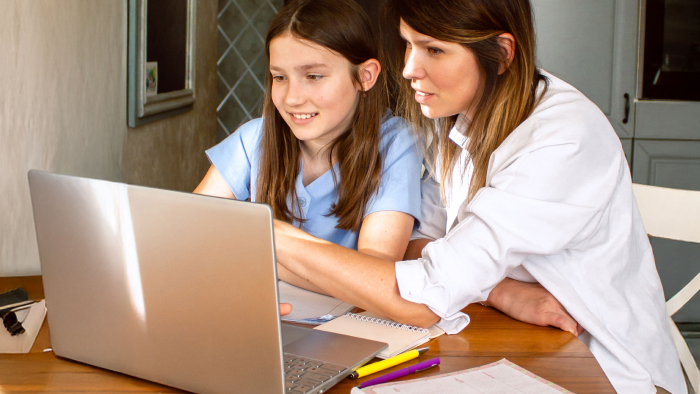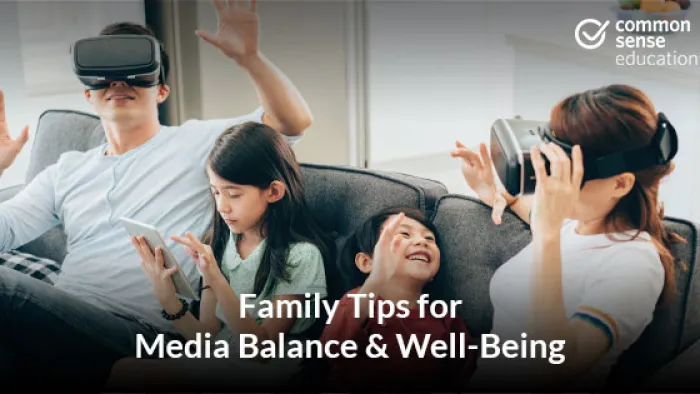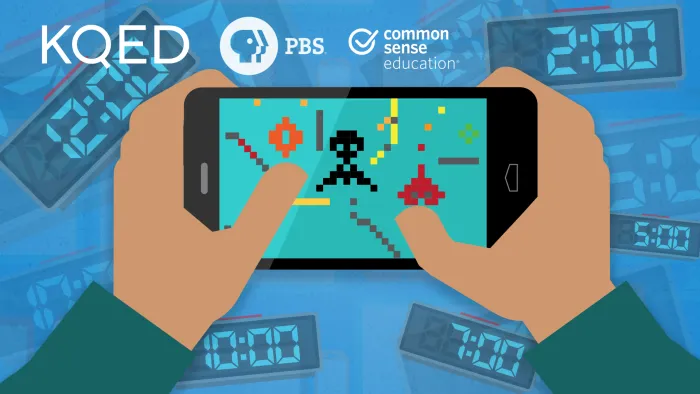Share these age-based tips in your communications with parents and caregivers.

As an educator, it's often easy to see when media and tech use at home are influencing what's happening in the classroom. And often, parents and caregivers are hungry for help! Being able to support students' learning around digital literacy and well-being by connecting those lessons to their home lives closes the loop and gets everyone on the same page.
Some of the hottest topics for parents revolve around two central questions: How much screen time is OK for kids of different ages, and is the media they love to use, watch, or play really OK for them? Though there are no hard-and-fast rules that apply to every kid or family, you can share guidelines, resources, and best practices that help families make informed decisions and feel more confident in their media and tech use at home.
Below, you'll find advice you can give when speaking with parents and caregivers. Further down you'll find copy-and-paste tips you can include in messages home, as well as linked resources to share.
Question: "Between school and home, my kid is on screens a lot, so how much time is too much?"
In Conversation with Caregivers
Important points for all parents and caregivers:
- There's no "right" number of hours.
- Age and stage matter, and the quality of content is crucial.
- It's important to find balance between screen use and other activities.
- Involving kids in the discussion around balance, screen use, and stopping places/times helps establish buy-in, limit conflict, and build self-regulation.
- Model and teach offline strategies to deal with difficult emotions, like anxiety and boredom.
- Stay curious about and familiar with what kids are watching, doing, and playing.
- Model the behavior you want to see, and talk about your own screen use with kids.
Important points for caregivers of grade K–2 students:
- This is a critical developmental stage, so limiting screen use is really valuable. Families can work on motor functions, emotional regulation, interpersonal skills, and more.
- When children do use screens, the quality of what they watch and play is essential. When you can, watch and play media together with kids.
- It's important to give kids opportunities for lots of different kinds of online and offline activities.
Important points for caregivers of grade 3–5 students:
- Work with your kids to find balance with other activities. A good starting point is to have family tech agreements that you create together. And encourage kids to be aware of how they feel when they use media, which will help develop their self-regulation.
- Make sure there are opportunities for physical activity, in-person social time, and ways to work on reading skills.
- Be familiar with the content your kid is using, because quality and safety of content is a factor in their development.
- Consider coordinating with other caregivers in your kid's orbit to reduce peer and social pressures and establish common ground rules for social gatherings (like what to do with phones at sleepovers, etc.).
Important points for caregivers of grade 6–8 students:
- Factor in the volatile physical, mental, and social changes happening right now (including a growing need for privacy and independence) as you include kids in expectations around screen use.
- Keep lines of communication open by leading with curiosity about why specific tech uses and content types matter so much to them.
- Help kids recognize and regulate when screen use affects their mental health in negative ways.
Important points for caregivers of grade 9–12 students:
- Help teens get enough sleep as school pressures increase by keeping phones (and other devices) out of bedrooms (or locked down except for music, etc.).
- Focus on helping them build self-regulation skills so teens can manage their own time using devices independently.
- Help teens reflect on how their screen use aligns—or doesn't—with their values and goals, and model this practice for them.
- Stay curious and involved, even as teens share less about what they do on their devices.
Resources to offer:
- Kids and Tech: How Much Is Too Much?
- Family Tech Planners
- Digital Literacy & Well-Being Family Activities, Podcast, Tips, Videos, and More
- Common Sense Media App

When Families Ask About Activities to Boost Digital Literacy & Well-Being
Invite parents and caregivers to try these digital citizenship activities at home!
Question: Is the content my kid is viewing/playing OK for them? How can I find good stuff that they'll like?
In Conversation with Caregivers
Important points for all parents and caregivers:
- Safety, privacy, and the content's messages and impact are the first things to consider in conjunction with your kid's developmental stage. Among the things to consider: open-ended chat features, data collection, violent or other mature content, antisocial messages, in-game purchases or ads, and even implicit messages about things like appearance.
- Learning opportunities are ideal, even if they're not intended. Of course, educational content is best, but kids can learn from everything. That includes games with strategy, apps that require patience, and TV shows that feature teamwork, especially if you ask kids about those elements to help them apply what they're watching or doing to their own life.
- A child's reactions and behavior during or after watching/playing matters, especially if they're acting like a mean character, having nightmares, or showing other signs of negative impacts.
- Find middle ground when you have kids of different ages watching or playing together so that little kids aren't exposed to content they're not ready for.
- Use sites like Common Sense Media to get a heads-up about the content ahead of time, or preview it before your kids get into it.
- Watch or play together whenever possible so you can share the experience and discuss it.
Important points for caregivers of grade K–2 students:
- Content made for learning is best for this stage, and there's plenty of amazing free stuff available from organizations with experts involved.
- Co-viewing whenever possible is extra important to help kids learn and process with you, especially since real vs. pretend can be confusing at this stage.
- Content with clear stopping points helps you and your kid so there are clear places to transition away from devices. This means turning off autoplay!
Important points for caregivers of grade 3–5 students:
- Peer input is more powerful, so before kids view or play, it's valuable to evaluate content together around your kid's readiness, interests, and your family's values.
- Kids want to watch YouTube, but they need limits and support to navigate it safely since it's not designed for kids, hosts mature stuff, and recommends content you might not want your kid to see.
- Avoid short-form videos (like YouTube Shorts, TikTok, or anything quickly scrollable) since they're not great for kids' learning or attention spans.
- Aim for videos and games that encourage creativity and curiosity.
Important points for caregivers of 6–8 students:
- Peer interaction is a huge influence, so evaluate together and come to initial "trial" agreements for apps or platforms that are new to your kid. This gives you visibility, builds trust (instead of "snooping"), provides scaffolding, and eases into exploration.
- Address natural curiosity about romantic relationships and sex with high-quality, positive content.
- Model and encourage reflection about positive and negative effects of digital life on well-being and self-regulation with digital habits.
- Discuss online content's messages, influences, and authenticity to boost media literacy skills.
Important points for caregivers of grade 9–12 students:
- Stay involved and curious about teen habits when it comes to viewing, gaming, and social media, even as they become more private and independent.
- Model and encourage reflection about the positive and negative effects of digital life on well-being and self-regulation with digital habits.
- Discuss online content's messages, influences, and authenticity to boost media literacy skills.
- Encourage teens to find content that fuels their passions and interests as they move into more independent futures.
Resources to offer:
- Selecting Quality Content for Your Family
- Family Engagement: Finding Quality Content
- Digital Literacy & Well-Being Family Activities, Podcast, Tips, Videos, and More
- Common Sense Media App
Copy & Paste Tips
Screen Time
If you're not sure how much time on screens is too much, here are a few things to keep in mind:
- There's no right or wrong number of hours. Your kid's age and developmental stage, a general balance of activities, the content itself, your individual child's needs, and the context are all factors.
- For all kids, it's important to engage in a balance of on- and off-screen activities and interpersonal interactions.
- Involving kids in the discussion around balance, screen use, and stopping places/times helps establish buy-in, limit conflict, and build self-regulation.
- Model and teach offline strategies to deal with difficult emotions, like anxiety and boredom.
- Stay curious about and familiar with what kids are watching, doing, and playing.
- Model the behavior you want to see, and talk about your own screen use with kids.
Quality Content
If you're not sure if the content your kid is viewing or playing is OK for them, here are some things to consider:
- Safety, privacy, and the content's messages and impact are the first things to consider in conjunction with your child's developmental stage. Among the things to consider: open-ended chat features, data collection, violent or other mature content, antisocial messages, in-game purchases or ads, and even implicit messages about things like appearance.
- Learning opportunities are ideal, even if they're not intended. Of course, educational content is best, but kids can learn from everything. That includes games with strategy, apps that require patience, and TV shows that feature teamwork, especially if you ask kids about those elements to transfer learning to offscreen life.
- A child's reactions and behavior during or after watching or playing matters, especially if they're acting like a mean character, having nightmares, or show other signs of negative impacts.
- Find middle ground when you have kids of different ages watching or playing together so that little kids aren't exposed to content they're not ready for.
- Use sites like Common Sense Media to get a heads-up about the content ahead of time, or preview it before your kids get into it.
- Watch or play together whenever possible so you can share the experience and discuss it.










